I stated in my “Thrombolites” article in our September 2013 Newsletter (No. 405) that “I couldn’t recall having heard of thrombolites”. That was despite the fact that I had previously mentioned them in my 1999 Journal article titled “Stromatolites”.
The second paragraph for the 6½-page article in Journal No.10, December 1999 stated,
“spherical-shaped stromatolites are known as Oncolites and (mound-like) cyanobacterial limestone growing on submerged trees are known as Thrombolites”.
The article went on to describe some thrombolites at Umm Said (on the south-east coast of Qatar). My September 2013 newsletter article “Thrombolites” quoted Wikipedia’s description of thrombolites as follows: –
“Thrombolites are clotted accretionary structures formed in shallow water by the trapping, binding, and cementation of sedimentary grains by biofilms of microorganisms, especially cyanobacteria (commonly known as blue-green algae).”
and
“Stromatolites are similar but consist of layered accretions.”
My article then went on to quote Wikipedia’s description of microbial mats. There wasn’t any reference to thrombolites in those details. There also wasn’t any reference to thrombolites growing on submerged trees in my newsletter article, unlike my 1999 Journal article. Although the Journal article discussed the stromatolites that occur in WA’s Shark Bay, it did not make mention of any others in WA at all. The thrombolites that I had seen on an ABC TV documentary were located at Lake Clifton in WA. I have wanted to write a follow-up article on stromatolites ever since the publication of our 2008 Journal (No.18). That Journal included a report about sediment sampling in Mount Gambier’s Blue Lake that same year (2008).
“Report on the Blue Lake Sediment Sampling & Research Programme February/March 2008” by Peter Horne makes several references to stromatolites (or a ‘stromatolitic field’ at least). The “first trial dive team” found “Some very unusual (presumably stromatolitic) formations”. A “stromatolite field” is said to occur at the north-west wall of the Blue Lake. The location is described as “a sheltered bay-like area (known as the “stromatolite field” because of the vast array of very picturesque stromatolitic structures to be found there) near a fissure in the northern wall of the lake”. A dive (or dives) at the site were described in the report. There were also many colour photographs showing the “stromatolite field”. There are also an aerial photo, some diagrams and maps. These can be found in the MLSSA 2008 Journal. One of the photos on page 29 of the Journal showed “some of the stromatolitic features which covered branches”. The photos shown below are from page 39 of the Journal. The top two photos show “Some stromatolitic features in the shallows above the final sediment-coring sample point”. The bottom photo shows one of the divers “hovering over a Chara (algae) bed”: –
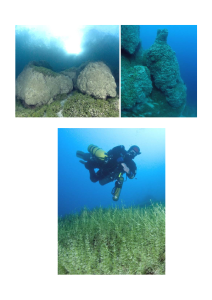 I didn’t know just what a ‘Chara bed’ was. A caption for one of the photos featured on page 28 of the Journal read “Stromatolitic formations and their accompanying Chara algaes”. I was unable to find any reference to ‘Chara algae’ in the text for the article. According to Wikipedia (http://en.wikipedia.org/wiki/Algae ), “The first plants on earth probably evolved from shallow freshwater charophyte algae much like Chara almost 500 million years ago. These probably had an isomorphic alternation of generations and were probably filamentous. Fossils of isolated land plant spores suggest land plants may have been around as long as 475 million years ago.”
I didn’t know just what a ‘Chara bed’ was. A caption for one of the photos featured on page 28 of the Journal read “Stromatolitic formations and their accompanying Chara algaes”. I was unable to find any reference to ‘Chara algae’ in the text for the article. According to Wikipedia (http://en.wikipedia.org/wiki/Algae ), “The first plants on earth probably evolved from shallow freshwater charophyte algae much like Chara almost 500 million years ago. These probably had an isomorphic alternation of generations and were probably filamentous. Fossils of isolated land plant spores suggest land plants may have been around as long as 475 million years ago.”
Also according to Wikipedia (http://en.wikipedia.org/wiki/Chara_%28alga%29 ), “Chara is a genus of green algae in the family Characeae. They are multicellular and superficially resemble land plants because of stem-like and leaf-like structures. They are found in fresh water, particularly in limestone areas throughout the northern temperate zone, where they grow submerged, attached to the muddy bottom. They prefer less oxygenated and hard water and are not found in waters where mosquito larvae are present. They are covered with calcium carbonate deposits.”
An attachment to the report (“Attachment A – Geology and Geomorphology Report – Blue Lake Research Dives – 29/30 March, 2008”) states, “Although stromatolitic formations have been found in many parts of the lake, the NW sector known as the “Stromatolite Field” (see Figure 3 on P 34) is currently the only area known where they appear in such numbers and varieties of form, as well as being found from just beneath the surface to a depth in excess of 25 metres (pers. comm. Peter Horne, 1985). This contrasts with the range and location of other stromatolites in the sinkholes of the region, which are richly-developed all around the sinkhole walls for 360 degrees. Possible explanations for the Blue Lake restricted zone may be:
- some factor of sunlight conditions in that corner (more shaded through the day)
- situated near the postulated jointing/faulting cluster in the NW walls where groundwater intake occurs
- factors of intake water freshness, chemistry and/or temperature at this point.
If the last point above applies, examination of the SE wall on the opposite side of the lake will provide interesting comparative evidence if stromatolites can be found there.”
A web search for “Where are stromatolites found?” led to the web page at http://jrscience.wcp.muohio.edu/fieldcourses01/papersmarineecologyarticles/stromatolites-thelongestl.html and information such as: – “Modern stromatolites were first discovered in Shark Bay, Australia in 1956, and throughout Western Australia in both marine and non-marine environments (Steneck, Miller, Reid and Macintyre, 1998). Stromatolites continued to be discovered in places, such as the thermal springs of Yellowstone National Park, USA, lakes in Antarctica, marine environment off the Bahamas, and in land-locked pools supersaturated with calcite on Aldabra, in the western Indian Ocean (McNamara and Awaramik, 1992).”
“The stromatolite continued to increase until the middle of the Riphean when they began a sharp decline (Awaramik and Sprinkle, 1999). The decline in stromatolites, during the Proterozoic, continued into the Phanerozoic eon. Scientists have attributed this drop in diversity and numbers to the increase in grazing metazoans, multicellular animals, and sediment disturbance by metazoans (McNamara and Awaramik, 1992). Some scientists dismiss this claim because there is no evidence in the fossil record of an increase in metazoans. Other theories re-grading the decline in stromatolite diversity include an increase in the occurrences of larger sediment accumulation, which would have been less suitable for stromatolite construction. As well, there could have been an increase in nutrient levels. Stromatolites prefer habitats with low nutrient levels. In a case at Lake Clifton in Western Australia, scientists are witnessing algae out-competing the cyanobacteria because of an increase in nutrient levels (McNamara and Awaramik, 1992).”
This last paragraph brought me back to the fact that the thrombolites that I had seen on an ABC TV documentary were located at Lake Clifton in WA. According to Wikipedia, “Lake Clifton is a small town located on the east side of the lake of the same name in the Peel region of Western Australia just off the Old Coast Road, between Mandurah and Bunbury at the north end of the Yalgorup National Park.” and “The Yalgorup National Park was established in the 1970s to protect the coastal lakes, swamps and tuart woodland in the area. The area is also central to waterbird migration patterns. At the edge of Lake Clifton, rock-like structures called thrombolites (similar to stromatolites) can be seen, built by tiny micro-organisms believed to resemble the earliest forms of life on Earth. Scientists have suggested their presence here may be due to upwellings of fresh groundwater high in calcium carbonate. An observation walkway has been constructed to allow visitors to view these fragile structures.”
Yalgorup National Park observation walkway
(Source: http://en.wikipedia.org/wiki/Lake_Clifton,_Western_Australia )
According to Wikipedia’s page on stromatolites, “A variety of stromatolite morphologies exists, including conical, stratiform, branching, domal, and columnar types.” That’s at least five varieties. According to the web page found at http://austhrutime.com/stromatolites.htm , “All 7 known varieties of stromatolite are found in the tidal and sub-tidal parts of Hamlin Pool (Shark Bay, Western Australia).”
Also on Wikipedia’s page on stromatolites, “Modern freshwater stromatolites – Laguna Bacalar in Mexico’s southern Yucatán Peninsula in the state of Quintana Roo, has an extensive formation of living giant microbialites (that is, stromatolites or thrombolites). The microbialite bed is over 10 km (6.2 mi) long with a vertical rise of several meters in some areas. These may be the largest sized living freshwater microbialites, or any organism, on Earth.
A little further to the south, a 1.5 km stretch of reef-forming stromatolites (primarily of the Scytonema genus) occurs in Chetumal Bay in Belize, just south of the mouth of the Rio Hondo and the Mexican border. Freshwater stromatolites are found in Lake Salda in southern Turkey. The waters are rich in magnesium and the stromatolite structures are made of hydromagnesite.
Another pair of instances of freshwater stromatolites are at Pavilion and Kelly Lakes in British Columbia, Canada. Pavilion Lake has the largest known freshwater stromatolites and has been researched by NASA as part of xenobiology research. NASA, the Canadian Space Agency and numerous universities from around the world are collaborating on a project centered around studying microbialite life in the lakes. Called the “Pavilion Lake Research Project” (PLRP) its aim is to study what conditions on the lakes’ bottoms are most likely to harbor life and develop a better hypothesis on how environmental factors effect microbialite life. The end goal of the project is to better understand what condition would be more likely to harbor life on other planets.
There is a citizen science project online called “MAPPER” where anyone can help sort through thousands of photos of the lake bottoms and tag microbialites, algae and other lake bed features. Microbialites have been discovered in an open pit pond at an abandoned asbestos mine near Clinton Creek, Yukon, Canada. These microbialites are extremely young and presumably began forming soon after the mine closed in 1978. The combination of a low sedimentation rate, high calcification rate, and low microbial growth rate appears to result in the formation of these microbialites.
Microbialites at an historic mine site demonstrates that an anthropogenically constructed environment can foster microbial carbonate formation. This has implications for creating artificial environments for building modern microbialites including stromatolites.
A very rare type of non-lake dwelling stromatolite lives in the Nettle Cave at Jenolan Caves, NSW, Australia (Jenolan Caves Reserve Trust. “Nettle Cave Self-guided tour”). The cyanobacteria live on the surface of the limestone, and are sustained by the calcium rich dripping water, which allows them to grow toward the two open ends of the cave which provide light (Cox G, James JM, Leggett KEA, Osborne RAL (1989). “Cyanobacterially deposited speleothems: Subaerial stromatolites”. Geomicrobiology Journal 7 (4): 245–252.).” and finally
“Stromatolites composed of calcite have been found in both the Blue Lake in the dormant volcano, Mount Gambier and at least eight cenote lakes including the Little Blue Lake in the Lower South-East of South Australia.”
So it seems that stromatolites are certainly recognised as occurring in the Blue Lake at Mount Gambier here in South Australia.
These microbialite towers at Pavilion Lake, British Columbia are very similar to those found in the Blue Lake (see above photos from page 39 of the 2008 Journal)
(Source: http://en.wikipedia.org/wiki/Stromatolite )
Proterozoic Stromatolites from Bolivia
(Source: http://www.angelfire.com/planet/pp0/infusoria.html )

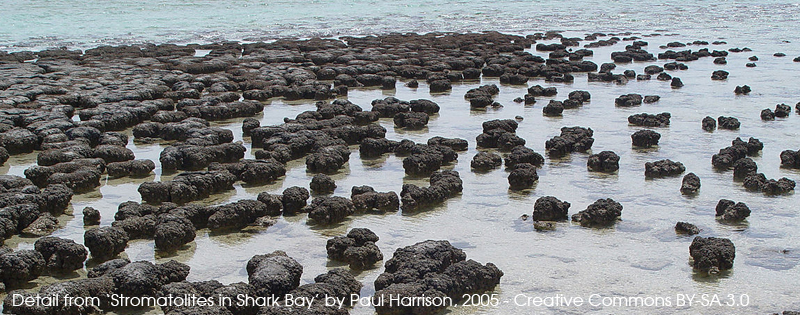
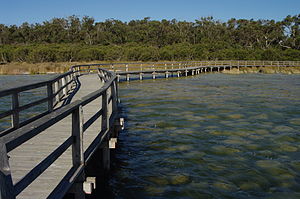
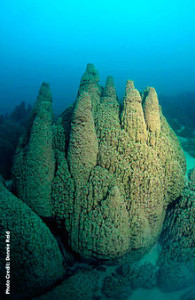
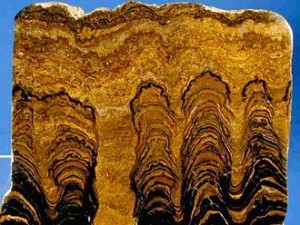
[…] https://mlssa.org.au/2014/07/06/stromatolites-part-2/ […]